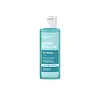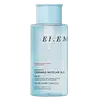What's inside
What's inside
 Key Ingredients
Key Ingredients

 Benefits
Benefits

 Concerns
Concerns

 Ingredients Side-by-side
Ingredients Side-by-side

Water
Skin ConditioningPEG-6 Caprylic/Capric Glycerides
EmulsifyingHexylene Glycol
EmulsifyingPEG-7 Glyceryl Cocoate
EmulsifyingPoloxamer 184
EmulsifyingDisodium Cocoamphodiacetate
CleansingDecyl Glucoside
CleansingGlycerin
HumectantCeramide NP
Skin ConditioningSalicylic Acid
MaskingCeramide AP
Skin ConditioningCeramide As
Skin ConditioningCeramide Ng
Skin ConditioningGlycolic Acid
BufferingPropanediol
SolventSodium PCA
HumectantMel
EmollientUrea
BufferingFructose
HumectantGlucose
HumectantCaprylic/Capric Triglyceride
MaskingCentella Asiatica Extract
CleansingSodium Hyaluronate
HumectantPotassium Hyaluronate
Skin ConditioningSodium Hyaluronate Crosspolymer
HumectantSodium Acetylated Hyaluronate
HumectantHydroxypropyltrimonium Hyaluronate
Hydrolyzed Hyaluronic Acid
HumectantHyaluronic Acid
HumectantHydrolyzed Sodium Hyaluronate
Skin ConditioningHydrogenated Lecithin
EmulsifyingPentylene Glycol
Skin ConditioningCitric Acid
BufferingGlycine
BufferingAcetyl Glucosamine
Skin ConditioningGlucuronolactone
Skin ConditioningLidocaine Hcl
1,2-Hexanediol
Skin ConditioningPolygonum Cuspidatum Root Extract
AntioxidantScutellaria Baicalensis Root Extract
AstringentCamellia Sinensis Leaf Extract
AntimicrobialGlycyrrhiza Glabra Root Extract
BleachingSucrose Stearate
EmollientPropylene Glycol
HumectantChamomilla Recutita Flower Extract
MaskingRosmarinus Officinalis Leaf Extract
AntimicrobialEthylhexylglycerin
Skin ConditioningHydrolyzed Collagen
EmollientCaprylyl Glycol
EmollientTropolone
Skin ConditioningGlycosphingolipids
EmollientTetrasodium EDTA
Cetrimonium Chloride
AntimicrobialSodium Chloride
MaskingSodium Glycolate
BufferingWater, PEG-6 Caprylic/Capric Glycerides, Hexylene Glycol, PEG-7 Glyceryl Cocoate, Poloxamer 184, Disodium Cocoamphodiacetate, Decyl Glucoside, Glycerin, Ceramide NP, Salicylic Acid, Ceramide AP, Ceramide As, Ceramide Ng, Glycolic Acid, Propanediol, Sodium PCA, Mel, Urea, Fructose, Glucose, Caprylic/Capric Triglyceride, Centella Asiatica Extract, Sodium Hyaluronate, Potassium Hyaluronate, Sodium Hyaluronate Crosspolymer, Sodium Acetylated Hyaluronate, Hydroxypropyltrimonium Hyaluronate, Hydrolyzed Hyaluronic Acid, Hyaluronic Acid, Hydrolyzed Sodium Hyaluronate, Hydrogenated Lecithin, Pentylene Glycol, Citric Acid, Glycine, Acetyl Glucosamine, Glucuronolactone, Lidocaine Hcl, 1,2-Hexanediol, Polygonum Cuspidatum Root Extract, Scutellaria Baicalensis Root Extract, Camellia Sinensis Leaf Extract, Glycyrrhiza Glabra Root Extract, Sucrose Stearate, Propylene Glycol, Chamomilla Recutita Flower Extract, Rosmarinus Officinalis Leaf Extract, Ethylhexylglycerin, Hydrolyzed Collagen, Caprylyl Glycol, Tropolone, Glycosphingolipids, Tetrasodium EDTA, Cetrimonium Chloride, Sodium Chloride, Sodium Glycolate
Ingredients Explained
These ingredients are found in both products.
Ingredients higher up in an ingredient list are typically present in a larger amount.
Ceramide NP is a type of ceramide and formally known as ceramide 3.
Ceramides are intercellular lipids naturally found in our skin that bonds dead skin cells together to create a barrier. They are known for their ability to hold water and thus are a great ingredient for dry skin.
Ceramides are an important building block for our skin barrier. A stronger barrier helps the skin look more firm and hydrated. By bolstering the skin ceramides act as a barrier against irritating ingredients. This can help with inflammation as well.
If you would like to eat ceramides, sweet potatoes contain a small amount.
Read more about other common types of ceramides here:
Ceramide AP
Ceramide EOP
Glycerin is already naturally found in your skin. It helps moisturize and protect your skin.
A study from 2016 found glycerin to be more effective as a humectant than AHAs and hyaluronic acid.
As a humectant, it helps the skin stay hydrated by pulling moisture to your skin. The low molecular weight of glycerin allows it to pull moisture into the deeper layers of your skin.
Hydrated skin improves your skin barrier; Your skin barrier helps protect against irritants and bacteria.
Glycerin has also been found to have antimicrobial and antiviral properties. Due to these properties, glycerin is often used in wound and burn treatments.
In cosmetics, glycerin is usually derived from plants such as soybean or palm. However, it can also be sourced from animals, such as tallow or animal fat.
This ingredient is organic, colorless, odorless, and non-toxic.
Glycerin is the name for this ingredient in American English. British English uses Glycerol/Glycerine.
Learn more about GlycerinPropanediol is an all-star ingredient. It softens, hydrates, and smooths the skin.
It’s often used to:
Propanediol is not likely to cause sensitivity and considered safe to use. It is derived from corn or petroleum with a clear color and no scent.
Learn more about PropanediolSodium Hyaluronate is hyaluronic acid's salt form. It is commonly derived from the sodium salt of hyaluronic acid.
Like hyaluronic acid, it is great at holding water and acts as a humectant. This makes it a great skin hydrating ingredient.
Sodium Hyaluronate is naturally occurring in our bodies and is mostly found in eye fluid and joints.
These are some other common types of Hyaluronic Acid:
Learn more about Sodium HyaluronateWater. It's the most common cosmetic ingredient of all. You'll usually see it at the top of ingredient lists, meaning that it makes up the largest part of the product.
So why is it so popular? Water most often acts as a solvent - this means that it helps dissolve other ingredients into the formulation.
You'll also recognize water as that liquid we all need to stay alive. If you see this, drink a glass of water. Stay hydrated!
Learn more about Water